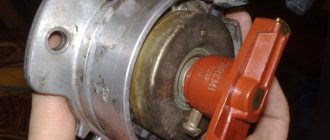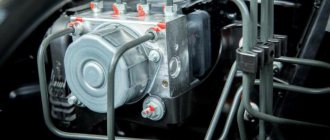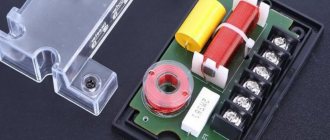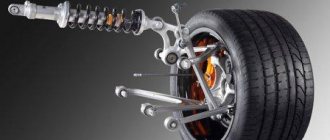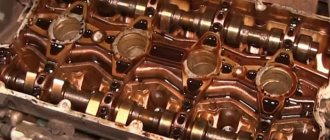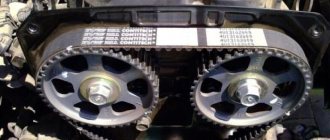I started the car in the evening, started it, and smelled something burning. The heater was turned on at first speed and when I started it, apparently all the energy was spent to start the engine, but the heater motor did not start. As a result, the heater heater resistor burned out. I turned on the 4th one, it works. And the stove fan works at 4 even without a resistor. Just don’t know why a turbo aircraft is needed at all)
The photo shows that the thermal fuse is located by bending it as close as possible to the heater resistor coil. If the resistor is heated to 117 degrees, its internal circuit melts and breaks. The same thing can happen when soldering a new one. But in fact, it burns out not from temperature, but from increasing current strength when the stove fan cannot move. When the fan cannot move, the load on this fuse increases to 17 amperes.
removed resistor In fact, the resistor itself rarely burns out; the shiny part soldered to pin 4, called a thermal fuse, burns out. Such fuses are still installed in irons and refrigerators. And since this is a fuse, it’s very easy to check whether the resistor itself is working; take any piece of wire and try to short it with a “bridge”. That's exactly what I did. I turned the heater on to first, shorted it out, it works at all speeds. If it works, then it's the fuse. We go to the radio parts store (“World of Electronics” SAMARA on Fizkulturnaya Street) and buy a new one for 15 amperes 117 degrees for 25 rubles. Solder in a new fuse. When soldering, do not overheat, overheating more than 117 degrees will cause the fuse to fail! You need to solder with a heat sink. Overheating will cause the part to become unusable. We put it in place under the glove compartment shelf. Voila, the stove works on all 4.
solder a new thermal fuse 15A 117*C How else can you stir it up, for example, if this crap burned out on the road? We take a large plastic 20A auto fuse, tear apart the body, cut off the thermal fuse from the resistor so that then, by bending the antennae, you can crimp the terminals. Just don’t turn it on immediately without pushing it into place under the glove compartment, it will melt without blowing. And it works with airflow.
quick option If you say that this is a collective farm option, then you can step it up like this, solder the mother terminals and insert a torn 20A fuse into the mother
option dad mom The option with soldering new fuses is the best. But they sell out quickly in electronics stores. I visited two stores. What do you think, where do the replaced resistors go in services? They sit and solder. Kalym!
Three main components of electric current
Electricity has become an integral part of our lives. It is used almost everywhere, including in vehicles.
This type of energy has three main components - voltage, current and resistance.
As for the last parameter, due to the possibility of creating additional resistance at any point in the electrical circuit, you can influence the first two parameters.
The main element for creating resistance is a resistor. This element is one of the most in demand, and not a single electrical circuit can do without it, and it will not be possible to replace it with anything else. And in any car there are plenty of electrical circuits.
Power dissipation
In addition to resistance, the resistor has another important parameter - power dissipation.
Any resistor acts as a kind of limiter and, due to its resistance, conducts only a certain voltage and current through itself. At the same time, the excess that it did not miss does not accumulate in itself, but converts it into thermal energy and dissipates it.
Therefore, resistors are designated by power dissipation.
The discrepancy between this element and its dissipation power will lead to its overheating and destruction. Power dissipation is measured in Watts.
The power dissipation can be determined both by the voltage passing through it and by the current strength.
Purpose
The main purpose of a resistor is to create resistance to be able to control and adjust the current and resistance. In fact, it is a kind of filter that allows you to obtain electricity with certain parameters at the output.
It provides all this by holding current, dividing and reducing voltage.
The main parameter of a resistor is the resistance it creates in the circuit, and it is measured in Ohms.
Resistors in the electrical circuit of a car.
It is precisely because of its function that this element is so often used in cars. Below we will look at some of the main components of a car, where a resistor is used and what specific function it performs there.
Sensors based on rheostats
There are direct relationships between the position of the rheostat slider, its resistance, the current in the circuit and the voltage. These features form the basis of the rotation angle sensor. Each position of the rotor in such a device corresponds to a certain electrical quantity.
Gradually, such sensors are being replaced by magnetic and optical devices. This is due to the fact that the characteristic of the dependence of angle and resistance is immune to interference from the influence of temperature. The transition to digital systems also contributes to the displacement of rheostatic sensors. Resistive meters can only be found in circuits that use analog signals.
Cooling system
So, the load resistor is used in the car’s cooling system, or more precisely, in the radiator fan power circuit.
It is worth noting that previously this electrical element was not used in this circuit, and everything worked very simply - when a certain coolant temperature was reached, the temperature sensor closed the contacts of the fan power circuit, and it started working.
The use of a resistor made it possible to make the fan motor operate in two or even three modes.
The process of supplying power to the fan has changed somewhat. Relays have also been added to the system, and in modern cars the electronic control unit is already responsible for turning on the fan.
That is, the electronic unit analyzes the temperature readings of the sensor and sends a signal to the relay.
Depending on the temperature, the relay directs electricity through a specific circuit. If the coolant temperature is slightly exceeded, but it is already required to be reduced, and a signal from the ECU is received, the relay directs electricity through a load resistor, which creates resistance, and the fan begins to rotate at low speed.
If the temperature continues to rise and reaches a critical point, the relay will redirect the electricity through another circuit - bypassing the resistor, directly to the fan, which will ensure its operation at full power, with a high rotation speed.
This is a dual-mode fan operation circuit, which is ensured by the presence of a load resistor in the circuit. Moreover, it is simplified to make it more understandable.
In a car with three-mode fan operation, the principle remains the same, but it already uses two resistors - one is responsible for low fan speeds, the second for medium ones.
The third mode is emergency, in which the fan rotates at maximum speed, and is ensured by supplying power directly to it.
GENERAL AIR CIRCULATION SCHEME
When there is no need for heating, intake air purified by the filter is supplied to the cabin directly from the environment. If the car is equipped with air conditioning, in cooling mode, the flow passes through the evaporator before entering the cabin, after which the cold air is directed into the deflectors (more about the principle of operation of the air conditioning system).
Air dampers
Redirection of air flows to regulate temperature is carried out by a special damper. Types of damper control:
- mechanical. The damper drive is connected directly to the switch in the cabin via rods and cables. In this case, the driver, by moving the regulator, manually doses the temperature of the incoming air;
- electronic. The damper is equipped with a servo drive. The electric motor changes the position of the damper, receiving commands from the control unit. This scheme is used on cars with climate control systems. The driver just needs to set the desired temperature in the cabin in the on-board computer, after which the electronic control unit, focusing on temperature sensors, will control the air damper servomotor.
Recycling
In recirculation mode, the main air damper closes, after which the heater fan begins to draw air from the passenger compartment. This mode of operation allows you to block the access of unpleasant odors and polluted air from the street if, for example, you are driving a car along a dusty gravel road.
Types of recirculation drive:
- mechanical (described above);
- vacuum. The damper is connected to the vacuum brake system. When the button is pressed, the valve moves due to the vacuum and remains in the closed position until the button is pressed again;
Ignition system
The second element of the car where you can find a resistor is the spark plugs. But not all candles are equipped with it.
It began to appear in the design of these elements not so long ago, and its task is to suppress radio interference.
By the way, there is now a lot of debate about whether it is needed in candles. After all, the resistor creates resistance, which ultimately affects the spark. But the stronger the latter, the better the combustible mixture ignites.
But in fact, the presence of a resistor has a slight effect on the quality of the spark, but only positively on the spark plug. A very strong spark charge leads to the destruction of the electrodes, and the resistance reduces the spark voltage.
But this is not its main purpose. A powerful spark discharge creates quite strong interference in the radio frequency range, which can affect the operation of a car audio system, mobile phone and any other equipment that is sensitive to this type of interference.
Interestingly, it is not necessary to install spark plugs equipped with resistors on the car.
The fact is that in many models a noise-reducing element is installed in the tips of high-voltage wires. Also, some types of wires themselves have quite good resistance, which is enough to suppress radio interference.
The resistor can also be installed in the distributor slider, and it is found there on many models. Its task is the same as that of a spark plug or tip.
It is important to understand that resistors cannot be used simultaneously in all of the listed ignition elements.
When these elements are connected in series, all the resistance they create is summed up.
That is, if a resistor is installed in the distributor runner, tip, or spark plug, then they will create such a strong resistance that they will significantly weaken the spark charge, and it will no longer be able to properly ignite the mixture. And this will lead to interruptions in engine operation, loss of power, and increased fuel consumption.
Therefore, deciding whether to install spark plugs with a resistor on a car is necessary by carefully reading the technical documentation that comes with the car.
If the manufacturer indicates that the use of such candles is necessary, then it is better to use them.
Operating principle
The operating principle of all rheostats is similar. The slider rheostat has the simplest design and visually clear principle of operation. It is connected to the circuit through the lower and upper terminals. The design is made in such a way that the current does not pass across the turns, but through the entire length of the wire selected by the slider. This occurs due to reliable insulation between the conductors.
In most slider positions, only part of the rheostat is activated. In this case, changing the length of the conductor leads to regulation of the current strength in the circuit. To reduce wear on the turns, the slider has a sliding contact, often made of a graphite rod or wheel.
The rheostat has the ability to operate in potentiometer mode. To do this, when making a connection, you must use all three terminals. The bottom two are used as an entrance. They are connected to a voltage source. The top and one of the bottom terminals are output. When you move the slider, the voltage between them is adjusted.
In addition to the potentiometer, a ballast mode of operation of the rheostat is also possible, when it is necessary to create an active load for energy consumption. In this case, it is necessary to take into account what scattering abilities the device has. Excessive heat can damage the device, so it is recommended to connect the rheostat to the network, having previously calculated the power dissipation and, if necessary, ensure sufficient cooling.
Interior heating system
Another element in the design of a car where a resistor is used is the interior heating system, or more precisely, the control of the operation of the electric motor of the stove.
Every car uses a variable resistor to change the speed of the heater motor.
In it, using a rotating element, it is possible to change the resistance value.
When the electric motor is turned on to the 1st rotation speed, the resistor provides maximum resistance; when switching to the 2nd speed, it decreases, and when switching to the 3rd speed, it is almost completely removed.
Location of the heater resistor on VAZ 2110-2112
To replace a burnt-out resistor yourself, it is enough to know where the part is located, as well as to have a minimum set of tools on hand. Regardless of what year the car is, the location of the rheostat remains the same - in the engine compartment, near the heater fan. During a visual inspection, this resistance block cannot be seen, because it is hidden by a plastic cover (“frill”).
For an accurate understanding of where the part is located, here is a photo.
Lighting
Recently, resistors have begun to be used in conjunction with LED lamps. This type of lamps has increasingly begun to be used on cars.
But not all cars yet come from the factory equipped with LED lighting devices, but it is quite possible to buy them separately and install them instead of standard incandescent lamps for the same turn signals or brake lights, and many do so.
But here a problem arises that requires the use of resistors.
The fact is that the electricity consumption of these lamps is very small, which is why the electronic unit regards the operation of the LEDs as a malfunction of the standard lamp.
To correct the situation, resistors are used to create a load on the wiring lines that power those lighting fixtures in which LED lamps are installed.
As a result, the ECU perceives the resistance of the element as the work of an incandescent lamp, so no error code occurs.
It is interesting that when using such decoys, the main advantage of LED lamps - low energy consumption - is reduced to zero, and they have only one advantage over conventional incandescent lamps - a long service life.
Why do you need a PC?
Based on what a rheostat is needed for, variable devices are divided into the following types:
- ballasts;
- launch RS;
- ballasts;
- load devices.
Ballasts
Rheostats are used in the control system of DC electric motors. With alternating current, the RS is included in the power supply circuit of asynchronous motors with a phase rotor.
Launcher PCs
Their main purpose is to reduce the inrush current during the start of the electric motor. Also, such rheostats work in regenerative rheostatic braking systems. It is needed to smoothly reduce the rotation speed of the rotors of electric motors and generators.
Ballasters
Ballast DCs quickly absorb the energy that is released during sudden braking of the electric motor. That is, ballast is discharged in the form of excess electricity.
Load devices
PCs of this type create additional load in the electrical circuit. This is necessary to maintain the necessary processes associated with the operating mode of various devices, engines and other devices.
Types of resistors, their features
Of the resistors described above that are used in the design of a car, two types can be noted - load, they are also constant and variable. In general, these are two main types that have fairly wide application in various fields.
Of course, there is a whole range of different resistors that differ in their design features. For example, thermistors, in which the resistance changes with temperature, or photoresistors, which change their parameters depending on the illumination. But we will not touch on them for now, but will consider only the two types indicated.
Fixed resistors are so called because the resistance they create is constant.
For example, if it is indicated that the main parameter of a given element is 30 Ohms, then it provides the resistance of exactly this value and it is impossible to change it.
In variable resistors, the resistance can be changed, manually. An example of this is the already mentioned control of the electric motor of the heating system.
Variable resistors also include trimmers.
In such resistors, you can also change the parameter manually, but its adjustment is not performed at any time, as is done in a variable one, but only when it is necessary to reconfigure the operation of the entire circuit in which it is included for a long period.
Trimmers are not used in vehicles, although they can often be found in household appliances.
Linear or logarithmic potentiometers
The most popular type of variable resistor and potentiometer is the linear type or linear taper, whose resistance value at pin 2 changes linearly with adjustment, creating a characteristic curve that is a straight line. That is, the resistive track has the same change in resistance per rotation angle along the entire length of the track.
Thus, if the wiper rotates at 20% of its total stroke, then its resistance is 20% of its maximum or minimum. This is mainly because their resistive traces are made of carbon composites, cermets or materials such as conductive plastics, which have a linear characteristic along their entire length.
But the resistive element of the potentiometer may not always produce a straight-line response or have a linear change in resistance over the entire range of travel when adjusting the wiper, but may instead cause what is called a logarithmic change in resistance.
Selecting a resistor by resistance
Most people, when an electrical appliance fails, send it in for repair or replace it, although in many cases it is the resistor that is to blame, especially since it is one of the most common elements in any circuit. But there are also those who undertake repairs on their own.
And often DIY repair enthusiasts have a question about how to choose the right resistor for a particular circuit.
To do this, let's take the simplest circuit, including a power source and one consumer.
Even at the beginning, it was indicated that electricity has three main characteristics - voltage, current and resistance. It is based on these parameters that all the necessary calculations are made using Ohm’s law.
According to this law, since we need to determine resistance, we should divide the voltage by the current.
For example, our power supply provides a 12 V circuit with a current of 0.02 A.
To determine the resistance, we carry out mathematical calculations - 12/0.02 and get a circuit resistance of 600 Ohms.
Now directly about how to calculate the resistance of a resistor for use in a particular circuit. For example, let's take a 12 V power source and a consumer (3.5 V incandescent lamp, 0.28 A).
First, the lamp resistance is calculated - 3.5/0.28 = 12.5 Ohms. Now we find out how much current will flow through the existing lamp - to do this, take the voltage of the power source and divide by the resistance: 12/12.5 = 0.96 A, which is 3.5 times the current required for the consumer to operate, and if you connect consumer, then the lamp filament will simply burn out.
To prevent burnout from occurring, a resistance in the circuit of 43.75 Ohms (12.5 * 3.5) is required. And since the lamp itself creates resistance, an additional 30 Ohm resistor must be connected to the circuit. During the calculations, we get - 12 V / 42.5 Ohm (lamp and resistor resistance) = 0.28 A.
That is, we received the current strength necessary for normal operation of the consumer. In this case, the element included in the circuit acted as a current limiter.
Design and principle of operation
If we consider the rheostat design, then it is necessary to note several of its main parts:
- This is a ceramic tube;
- a metal wire is wound around it, the ends of which are brought out to contacts located at opposite ends of the ceramic tube;
- a metal rod is installed above the tube, on one side of which a contact is made;
- A moving contact is attached to the rod, which electricians call a slider.
Now how does it all work. Pay attention to the picture below.
The first position (a) is the contact (moving) in the middle. This means that the current will only pass through half of the device. The second position (b) indicates that the conductor is fully engaged. That is, its length is maximum, which means the resistance is maximum, while the current strength has decreased. It is clear that the greater the resistance, the less the current. The third position (c) – here everything is the other way around: the resistance decreases, the current increases.
I would like to draw your attention to the fact that the ceramic tube used in the rheostat design is hollow. This is a necessary component that allows the device to cool when electricity passes through the conductor. Let us add: it is believed that the safest rheostats are those that are covered with a casing.
Replacement steps
This task is not difficult, but painstaking and difficult for absolute beginners. To avoid any difficulties, you must strictly follow the work plan described below.
- Disconnecting the “−” terminal of the battery and the wire.
- Dismantling the frill.
- Disconnecting the block with wires from the connector on the additional rheostat.
- Removing the fasteners on the resistor using a Phillips screwdriver of the appropriate size.
- Removing a faulty mechanism on the heater.
- Installing a working mechanism according to the same scheme, but in reverse order.
Dismantling the frill
This process is listed as one of the stages of work to replace the stove on Priora. It will not be possible to bypass it, especially since the frill will have to be removed when solving many problems with the heater. Even a basic filter replacement will require dismantling the windshield trim, also called a frill. To implement this task, you will need a thirteenth head, a screwdriver with a flat and Phillips head, and a marker. Further work will proceed according to the following scenario:
- We remove the windshield wiper blades.
- Using a marker, we make marks on the windshield that will indicate the location of the blades.
- We take out the decorative caps, which you just need to pry off with a screwdriver.
- Using a socket, unscrew the fastening nuts from the brush lever.
- It is convenient to remove the washers using tweezers.
- We remove the lever and brush from the shaft.
- We open the hood to carry out dismantling work regarding the seal, which is located on the edge of the front panel upholstery.
- We unscrew the fastening on the facings, dashboard upholstery, wind window trim.
Manufacturing materials
What is insulation resistance measurement and why is it important
Rheostats are divided into 4 types based on the type of material they are made of. These are carbon, metal, liquid and ceramic RS:
- Carbon devices include models where a graphite rod acts as a variable resistance.
- A metal example of execution can be slider rheostats. They have a variable resistor - a coil of metal wire.
- Liquid variable resistances are used to control the operation of electric motors in explosive atmospheres.
- Ceramic rheostats include toroidal devices. Their device is described above in the text.
Self-diagnosis of stove malfunction
Read also: What is electrolysis of hair
If the safety elements are intact, you need to check how efficient the fan is by first opening its power supply connector. The electric motor in the stove is located either in the space under the hood (behind the engine shield near the passenger compartment), or under the dashboard of the car interior.
The location of the heating fan and how to open it are in the vehicle operating instructions. There is also a circuit for starting the fan.
When studying the circuit, you need to find out which of the connector pins of the electric motor is positive when starting the first speed of the fan. Next, any contact of the control device is connected to this pin, another of its contacts is shorted to ground, the ignition system is turned on and the fan switch is turned to any position. If the control lamp turns on, then the cause of the fan malfunction is the electric motor. Otherwise, fan malfunctions occur due to a break in the wiring leading to the heating switch.


